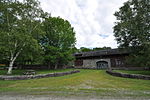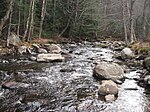Felsengarten
Bethlehem, New HampshireHouses completed in 1896Houses in Grafton County, New HampshireHouses on the National Register of Historic Places in New HampshireNational Register of Historic Places in Grafton County, New Hampshire

Felsengarten (German for "stone garden") is a historic summer house on Lewis Hill Road in Bethlehem, New Hampshire. The two story house was built between 1896 and 1900, and was the summer residence of German-American conductor Theodore Thomas and his wife Rose Fay. Thomas was an influential figure in popularizing classical orchestral music in the United States during the 19th century. The house and garden were listed on the National Register of Historic Places in 1973.
Excerpt from the Wikipedia article Felsengarten (License: CC BY-SA 3.0, Authors, Images).Felsengarten
Lewis Hill Road,
Geographical coordinates (GPS) Address External links Nearby Places Show on map
Geographical coordinates (GPS)
| Latitude | Longitude |
|---|---|
| N 44.255555555556 ° | E -71.705555555556 ° |
Address
Felsengarten
Lewis Hill Road 878
03574
New Hampshire, United States
Open on Google Maps







